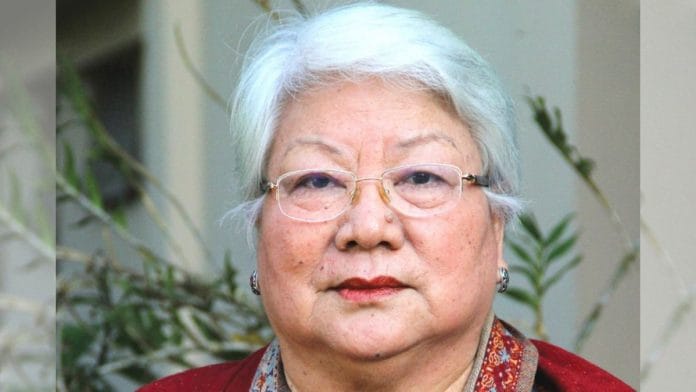Every winter, as the chill of the season set in, Temsula Ao would transform an ordinary ritual into a profound act of love. The Padma Shri award-winning poet, women’s rights activist, and ethnographer from Nagaland would gather clothes she no longer needed, carefully selecting pieces for her relatives in her village. Ao’s philosophy was clear—nothing worn out, torn, or faded would do.
“Kia-lu teuk sungko Kibo,” she would say in her mother tongue, which meant, ‘If you give, give till the eyes are full’,” Ao’s daughter, Jungmayangla Longkumer, a professor at Nagaland University, told ThePrint.
It’s a striking example of how Ao, a fierce advocate for Naga cultural preservation, infused her life with resilience and love. Her work—poems, fiction, essays, and activism—was forged from the need to reconstruct the forgotten Naga identity, which got subsumed with the rise of Christianity during a time when Nagaland was torn apart by insurgency.
A Fulbright fellow, she was dean of the School of Humanities and Education at North Eastern Hill University in Shillong and chairperson of the Nagaland State Commission for Women, where she advocated for women’s inclusion in village councils and equal inheritance rights to ancestral property.
“Temsula Ao is not [just] an individual; she was an institution—a scholar, peace activist, thinker, friend, and a beautiful human being all in one,” said Walter Fernandes, a Guwahati-based scholar and director of North Eastern Social Research Centre (NESRC), when she passed away in 2022.
Also read: Thilakan called out Malayalam movie mafia before Hema committee report. He was banned for it
Resilience and Naga roots
Ao, who was born in undivided Assam’s Jorhat in 1945, lost both her parents as a child. As an orphan, she navigated her childhood with unwavering strength. As a single mother, she turned household chores into lottery games and was always a relentless seeker of stories and oral traditions.
She revisited her life events in her memoir, Once Upon a Life: Burnt Curry And Bloody Rag (2014).
“I was married off even before my Matric results were out. It is because of these events that I used the term ‘fractured childhood’ in my memoir to describe a very bewildering and difficult childhood and adolescence,” she said in a 2017 interview with Thumbprint magazine.
Temsula Ao’s transformative journey as a Fulbright Fellow at the University of Minnesota shaped her perspective on Naga culture.
“Seeing Native Americans struggle to learn their language profoundly impacted her and inspired her to write The Ao-Naga Oral Tradition,” Longkumer told ThePrint. This realisation made her reflect on her own language and the challenges faced by her people, igniting her passion for cultural preservation and a desire to celebrate her heritage. She always wore the traditional Mekhela crafted by local weavers to work and church—a gesture to honour her Naga heritage.
Her works, such as These Hills Called Home: Stories from a War Zone (2005), portray the vital role of women in Naga society and their strength amid conflict.
“The emphasis was not to identify ‘winners or losers’ but to empathise with the ‘victims’ on both sides,” she said in the 2017 interview, acknowledging the challenging question of Naga society’s future in transition. For Ao, the conflict in These Hills Called Home served merely as a backdrop; her focus instead was on the human suffering endured by victims—whether militants or state forces. In 2013, she received the Sahitya Akademi Award for her collection of short stories, Laburnum for My Head.
Despite marrying young, she never allowed her circumstances to dictate her future. With relentless determination, she pursued education and eventually secured a teaching position at NEHU in Shillong. Her strength and resolve were evident in her willingness to stand up against ethnic aggression.
“One of her colleagues recounted how my mother alone stood up to a riled-up group and protected her when she was attacked along ethnic lines,” said Longkumer.
While her work undoubtedly impacted national conversations about Naga literature and culture, she remained an intensely private person who shunned the spotlight. Self-glorification was not in her nature; she simply loved writing, and that passion mattered most to her.
“Reading serious literature is not something Nagas are famous for,” Ao said in an interview, highlighting the historical emphasis on oral traditions within the Naga community, where storytelling and cultural teachings have been passed down orally rather than through written texts.
Also read: Bimla Buti didn’t study science until university. Vikram Sarabhai handpicked her to lead PRL
Life lessons and joys
Never losing touch with her roots, Ao’s visits to the village of Jorhat were the highlight of her family holidays. Gathered around the fireplace, they listened to stories from the elders while she diligently recorded every detail, often asking them to repeat themselves and answer her endless questions whenever a tale captured her intrigue.
“She had a caustic sense of humour and would often say unexpected things that not only made us laugh but also [made us] reflect,” Longkumer said, illustrating her unique ability to blend humour with profound insights.
One luxury she allowed herself was her love for tea. For her, every cup was special, and she insisted that even the second cup be freshly brewed.
Longkumer recalled how they felt “rich throwing away freshly brewed tea just to make another fresh cup”. In those moments, they revelled in the simple joy of a strong, hot cup, never feeling the weight of poverty.
“My mother dared to be and she dared to do,” Longkumer said.
In her poem October, she wrote, “And when the time is ripe for me, I wish to depart with October in my heart,” a sentiment that resonates deeply since she passed away in this month. For Ao, October symbolised the cycles of life and the inevitability of change—both beginnings and endings—a time of transition where the hues of autumn reflected the complexities of life. She passed away at the age of 76 on 9 October 2022.
(Edited by Prashant)






